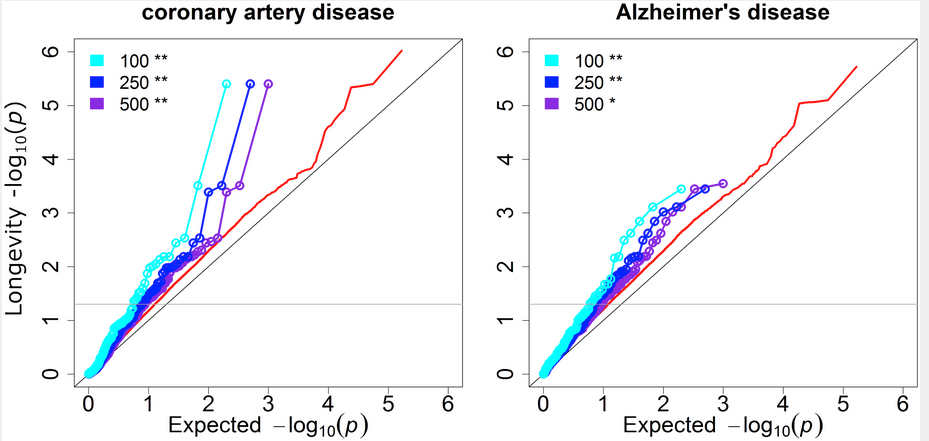
Disease GWAS show substantial genetic overlap with longevity. Shown are results for coronary artery disease and Alzheimer’s disease. The y axis is the observed P values for longevity, and the x axis is the expected P values under the null hypothesis that the disease is independent of longevity. The cyan, blue and purple lines show the P values for longevity of the top 100, 250, and 500 disease SNPs from independent genetic loci, respectively. Red lines show the background distribution of longevity P values for all independent genetic loci tested in both the longevity and disease GWAS. The grey horizontal line corresponds to the threshold for nominal significance (P< = 0.05) for longevity. Significance of enrichment was determined with the hypergeometric test. (credit: Kristen Fortney et al./PLOS Genetics)
What’s the secret of centenarians who have health and diet habits similar to the average person but have remained active and alert at very old ages?
Genes. That’s according to scientists at Stanford University and the University of Bologna, who have written a new report published in PLOS Genetics, based on their finding of several disease variants that may be absent in centenarians compared to the general population.
Genetic studies so far have only identified a single gene (APOE, known to be involved in Alzheimer’s disease) that is different in centenarians versus normal agers.
Finding additional longevity genes
To find the additional longevity genes, the authors first developed a new statistical method called informed GWAS (genome-wide association studies), which uses knowledge from 14 diseases to narrow down the search genes associated with longevity.
Using iGWAS, the scientists found eight SNPs (single nucleotide polymorphisms — molecular variations at different locations on the gene) that are significant for the centenarians they studied, and they were able to validate four of these in replication studies of long-lived subjects.
The four “longevity loci” (gene locations) along with the APOE gene may provide clues about physiological mechanisms for successful aging. These loci are known to be involved in various processes including cell senescence, autoimmunity, and cell signaling, and also with Alzheimer’s disease.
The incidence of nearly all diseases increases with age, so understanding genetic factors for successful aging could have a large impact on health. Future work may lead to a better understanding of how these genes promote successful aging and could identify additional longevity genes by recruiting more centenarians for analysis.
Abstract of Genome-Wide Scan Informed by Age-Related Disease Identifies Loci for Exceptional Human Longevity
We developed a new statistical framework to find genetic variants associated with extreme longevity. The method, informed GWAS (iGWAS), takes advantage of knowledge from large studies of age-related disease in order to narrow the search for SNPs associated with longevity. To gain support for our approach, we first show there is an overlap between loci involved in disease and loci associated with extreme longevity. These results indicate that several disease variants may be depleted in centenarians versus the general population. Next, we used iGWAS to harness information from 14 meta-analyses of disease and trait GWAS to identify longevity loci in two studies of long-lived humans. In a standard GWAS analysis, only one locus in these studies is significant (APOE/TOMM40) when controlling the false discovery rate (FDR) at 10%. With iGWAS, we identify eight genetic loci to associate significantly with exceptional human longevity at FDR < 10%. We followed up the eight lead SNPs in independent cohorts, and found replication evidence of four loci and suggestive evidence for one more with exceptional longevity. The loci that replicated (FDR < 5%) includedAPOE/TOMM40 (associated with Alzheimer’s disease), CDKN2B/ANRIL (implicated in the regulation of cellular senescence), ABO (tags the O blood group), and SH2B3/ATXN2 (a signaling gene that extends lifespan in Drosophila and a gene involved in neurological disease). Our results implicate new loci in longevity and reveal a genetic overlap between longevity and age-related diseases and traits, including coronary artery disease and Alzheimer’s disease. iGWAS provides a new analytical strategy for uncovering SNPs that influence extreme longevity, and can be applied more broadly to boost power in other studies of complex phenotypes.
